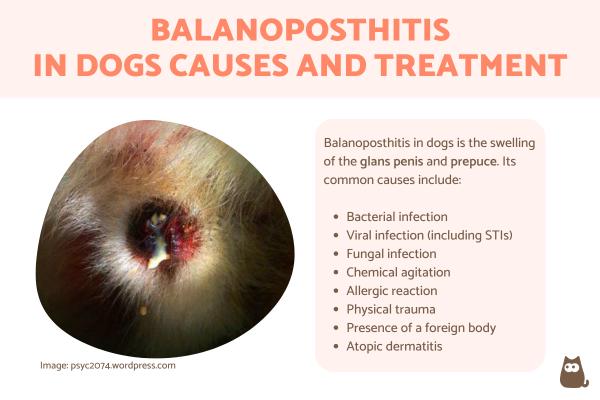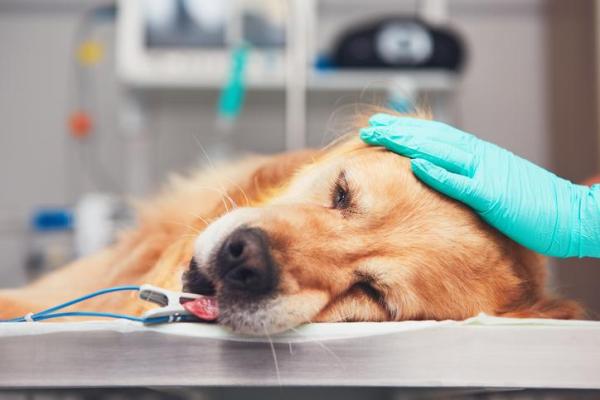
There is nothing abnormal about a dog licking his penis or genital area. This the best way for the dog to maintain hygiene. As with any canine behavior, if your dog licks their privates too often, it could be a sign of a health issue. Diseases and health problems of the penis are relatively common in dogs. This vulnerable area can easily come in contact with bacteria in the environment. Running over long grass or lying down on the ground can make their undercarriage exposed, so it is understandable their penis might be vulnerable to infection.
AnimalWised looks into the causes, treatment and symptoms of balanoposthitis in dogs to help us if we see our dog has a problem with their penis. We will also look at other reasons a dog might lick their private area, but it is important to stress a veterinarian visit will be required to achieve a proper diagnosis.
What is balanoposthitis in dogs?
Any disease ending in -itis refers to an inflammatory condition. The related condition balanitis is a general term for the inflammation of the glans penis. Balanoposthitis is when this inflammation also occurs in the prepuce, the sheath of fur covered skin which protects the penis when flaccid. This is the canine equivalent of a foreskin in humans. It is a fairly common condition in dogs, resulting in approximately 20% of canine penile and preputial lesions[1].
The integumentary system is the term for the combined physical elements an animal uses to protect itself from external damage. For example, fur protects them from the cold and skin protects them from their innards falling out. The penis is a particularly vulnerable appendage, so the prepuce is a necessary part of this integumentary system. While physical trauma to this area is possible, the dog knows instinctively to protect it. Causes of balanoposthitis tend to have more to do with underlying medical conditions and hygiene.
Although balanoposthitis is a relatively common condition in dogs, it is also important to note it is not often acute. It can occur in dogs at any age (including puppies), although it is much more common in dogs which have reached sexual maturity. It is also a condition which usually presents in mild symptoms.
The symptoms of balanoposthitis in dogs will usually clear up on their own without veterinary medical intervention. When they do not, it can lead to a more severe infection which will require treatment. This can be exacerbated by concurrent health issues such as another infection, a weakened immune system, underlying health problems or even physical trauma. The swelling or inflammation may not always be very evident, nor can purulent discharge (i.e. pus) be seen easily in mild cases. This is why we need to be careful and look out for other symptoms.
Discover another inflammatory disease which can affect the genitourinary tract with our article on enteritis in dog.
Causes of balanoposthitis in dogs
Since balanoposthitis is a general term for inflammation of a dog's penis and prepuce, its causes can be varied. They are similar to the causes of balanitis in dogs include:
- Bacterial infection
- Viral infection (including STIs)
- Fungal infection
- Chemical agitation
- Allergic reaction
- Physical trauma
- Presence of a foreign body
- Atopic dermatitis
The most common cause is opportunistic bacterial infection. Bacteria in a dog's environment, whether inside or outside the home, can find its way onto the dog's genitals. It can even occur when the dog is licking themselves for hygiene purposes. If they have bacteria on their mouth, perhaps from eating something unhygienic, they can pass it onto their genital region. The main types of bacteria responsible for balanoposthitis are:
- Pseudomonas aeruginosa
- Streptococcus pyogenes
- Staphulococcus aureus
- Klebsiella sp.
These bacteria are naturally present in the foreskin of the dog. When conditions are conducive, they proliferate and cause problems when in excess amounts. This is why they are called opportunistic bacteria. Other microorganisms commonly involved in balanoposthitis in dogs are Mycoplasma. Ureaplasma species may also be involved, although this is less frequent.
Sexually transmitted diseases or infections in dogs are possible causes of prepuce inflammation, especially in dogs which have not been properly vaccinated. The herpes virus is one of the most common STDs in dogs. The result of the infection can lead to inflammation of the penis and/or prepuce. This goes to show that balanoposthitis is a symptom of another condition or disease rather than a disease in its own right.
It is very rare for cancer to be contagious, but something known as transmissible venereal tumors (TVTs) can occur in dogs. This is a sexually transmitted cancer. One of the symptoms is inflammation of the penis and prepuce.

Symptoms of balanoposthitis in dogs
The most common sign of balanoposthitis in dogs is the presence of pus on the dog's penis. Depending on the type of infection, the pus may be colored various shades of yellow or green. Blood may also be present, especially if the case becomes severe. There are other symptoms which may present, including:
- Inflammation of the glans and prepuce
- Redness
- Excessive licking of the genitals
- Secretion of pus from the penis
- Secretion of blood from the penis
- Lesions on the penis
- Abnormal growth on the penis
- Difficulty urinating
- Irritation
- Pain
There may be a foul odor emanating from the genital region, but this will not likely be as noticeable as visual symptoms. Bacterial infection can become acute if left untreated which is why it is so important to take the dog to a veterinarian whenever symptoms first appear. Although it can be difficult to detect, we may also see the dog pee a little blood. This can be seen in dark or reddish urine.
Diagnosis of balanoposthitis will first require a physical examination of the dog's genitals by a veterinarian. They will not usually need to carry out other diagnostic tests unless presence of a different condition is suspected. In these cases (or if the dog does not respond to treatment), a sample will need to be cultured to identify the type of bacteria present.
It is important to note that a dog's penis is self-lubricating. This means it produces a secretion which is used to lubricate it for various movements. Said secretion can mix with dead skin cells to form something called smegma. This is a normal secretion and something which does not indicate a medical problem. Removal of smegma is one fo the reasons dog lick their genitals.
Treatment of balanoposthitis
As balanoposthitis is a symptom and not a disease in itself, treatment will depend on the underlying cause. Mild cases of the condition may not even require treatment, but will be able to resolve in due time. In more acute cases, the dog will first need to be washed with a mild antiseptic. The type of antiseptic needs to be approved by the vet, otherwise it can cause further irritation.
Cleaning the area properly may require douching with sterile water or involve clipping of the hair around the penis. Bacteria can cling to this fur, so its removal will be helpful in keeping the area clean.
Antibiotics may need to be introduced in severe infections. These can be given orally or may even be used in an antibiotic ointment on the penis. This later option is less likely as it may be difficult for some dog owners to provide the treatment. If a foreign body is present, then its removal will be required to stop infection. Surgery is possible if the object is lodged in the penile canal, but this is very uncommon. If balanoposthitis is due to canine atopic dermatitis, the veterinarian may prescribe antihistamines or corticosteroids.
If the dog has not had access to treatment, the condition may worsen. It will depend on the cause, but if there is tissue necrosis, laceration or abscess, a surgical penectomy may be required. Sterilization in the form of castration can help to prevent balanoposthitis in dogs, but it will only reduce the possibility. It will not prevent it altogether.
As we said above, the reasons for a dog licking their genitals may be to relieve the symptom of balanoposthitis, but the underlying cause can vary. One other cause which may or may not be due to the condition is phimosis. This is an abnormally small prepuce orifice, which makes it difficult for the penis to extrude itself[2]. It can occur from the time the dog is a puppy, but it may not be noticed until sexual maturity or when they have trouble mating.
As phimosis may cause trouble urination, it is something which may be noticed when the dog is unable to pee properly. Balanitis or balanoposthitis is a possible cause, but it is more commonly a genetic inheritance. Treatment is usually surgical.

What is the difference between balanoposthitis and balanitis in dogs?
You may be confused as to the difference between balanitis and balanoposthitis. This is easily done since the conditions are closely related. Simply put, balanitis in dogs is the swelling of the glans penis. This is the tip of the penis which is attached to a bulbous base. Balanoposthitis is the inflammtion of the glans penis and the prepuce.
If the dog's glans penis is swollen due to infection or other inflammatory processes, it is likely this problem will spread to the nearby prepuce or foreskin. It is possible for the prepuce to be inflamed and not the penis, but it is more common for the general area to experience this symptom.
Learn more about this condition with our article explaining why a dog has a swollen penis.
This article is purely informative. AnimalWised does not have the authority to prescribe any veterinary treatment or create a diagnosis. We invite you to take your pet to the veterinarian if they are suffering from any condition or pain.
If you want to read similar articles to Balanoposthitis in Dogs - Causes, Symptoms and Treatment, we recommend you visit our Reproductive system diseases category.
1. Birchard, S. J., & Sherding, R. G. (Eds.). (2006). Handbook of small animal practice (5th ed.). Saunders. https://www.sciencedirect.com/book/9781416039495/handbook-of-small-animal-practice
2. Vadalia, J. V., Patel, A.M., & Kumar, V. (2014). Surgical Management of Congenital Phimosis in Pup. Intas Polivet, 15(1), 160-16.
- Kustritz, M. V. R. (2001). Disorders of the canine penis. Veterinary Clinics of North America: Small Animal Practice, 31(2), 247–258.
https://doi.org/10.1016/S0195-5616(08)70014-5 - Davidson, A. P. (n.d.). Balanoposthitis in small animals. MSD Veterinary Manual. https://www.msdvetmanual.com
- Volpato, R., et al. (2010). Penile and prepuce disorders of dogs: Literature review. Veterinary and Animal Science, 17(3), 312–323